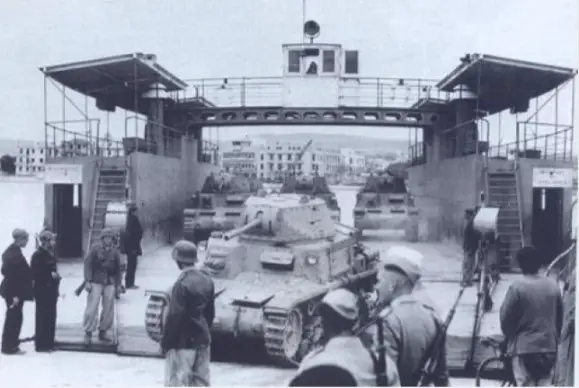The allied landings of Operation Torch forced the Axis to make strategic decisions in the Mediterranean theatre, this led to the beginning of the Tunisian campaign

Securing Tunisia
Operation Torch, the series of Allied landings in French-controlled North Africa in November 1942, was the main game-changer of the Mediterranean Theatre. The superiority in military assets retained by the Allies (thanks to the American intervention), and the threat of trapping Rommel’s forces between two advancing Allied armies, constituted a serious issue for the Axis powers.
German and Italian military leaders saw an immediate solution in establishing a strong foothold in Tunisia, to cover the back of the Army retreating from El-Alamein.
Already on the 9th of November, German paratroopers landed in Tunisia, securing a series of airfields, in agreement with the Vichy-French authorities.
On the 11th of November, Germany and Italy decided to occupy Southern France and Corsica, to secure the Vichy-held territories.
From the 12th of November, the first naval convoys organized by the Regia Marina began to arrive in Tunisia, landing companies of Panzergrenadieere and Fallschirmjägers. The Italian army brought in the 10° Bersaglieri regiment, an infantry regiment of the Superga division, a group of SPGs 75/18 of the Centauro armoured division, the battalions Bafile and Grado of the San Marco Marines regiment and a battalion of the Assault Paratroopers of the Regia Aeronautica.
German General Walter Nehring assumed temporarily the command of the Axis forces in Tunisia. Admiral Luigi Biancheri of the Regia Marina assumed the command of Bizerte.
General Nehring received the following instructions from Kesserling: 1) to push west 2) consolidate the axis foothold 3) gain time and room for manoeuvre.
To this end, Nehring ordered to attack the British columns that were advancing from Bone (taken on the 12th of November). This resulted in harsh fights that raged between the 17th and 23rd of November. (marked by the red circles in the map) In the clashes around Djebel Abiod, the paratroopers of the Regia Aeronautica supported the German Fallschirmjägers commanded by Colonel Witzig (the hero of Eben Emael). This mixed and lightly-armed force routed the British vanguard (“Hart Force”) but had to withdraw when the 36th infantry brigade came forward, supported by heavy artillery.

Axis bridgehead 17-24 November 1942
Fearing an allied advance on Sfax from Gabes, that would have isolated the Axis forces in northern Tunisia, Nehring sent a mixed group of Italian forces to the south, with the objective of occupying Sfax and then moving west towards Gafsa.
These units were scattered elements of the Superga Infantry Division and of the 50° Special Brigade, which included a tank battalion and a few SPGs.
These troops, led by General Imperiali, secured Sfax and pieces of central Tunisia by the 21st of November but failed to control Gafsa which was taken by the American 2nd Corps.
Commandos incursion
On December 1, 1942, Allied commandos made a surprise landing on the northern coast of Tunisia, northwest of Bizerte. They were 500 men with the task of infiltrating the rear of the axis and blocking the road between Bizerte and Mateur. Initially, the plan seemed to go well.
Soon however, the presence of the commandos was detected and the 10th Bersaglieri Regiment moved to neutralize the enemies. The first battle took place around 10 in the morning and the Bersaglieri took 50 Allied prisoners. The commandos suffered further losses in subsequent engagements, before deciding to fall back towards the British lines.
The December counteroffensive
For the time being, Tunis and Bizerte seemed secure but the threat of Allied land units still nearby caused a lot of concerns. Thanks to the arrival of the 10th Panzer Division, which included a company of the brand-new Tiger tanks, General Nehring launched a counteroffensive in the direction of Tebourba and Medjez el Barb. The first week of fighting saw the advance of the German forces, with the Allies retreating in disorder. This allowed a general stabilization of the front and made realize to the Allied commanders that the Axis bridgehead was now able to launch strong offensive operations, while their logistic lines were still too stretched along Algeria and their units still needed time to gather.

Situation on the 15th of February 1943
Change of leadership and restructuring
After the successful actions of early December, the Axis forces in Tunisia strongly needed a general re-organization since they had been rushed to action soon after their arrival. This process took place roughly in the remaining part of December, also thanks to the operational pause initiated by the allies, who, in addition, were slowed down by heavy rains.
On the 8th of December, General Nehring was replaced by General Von Arnim. The array of Axis forces under his command became the V Panzerarmee.
In Libya, Rommel was still retreating and by January 1943, his forces were fighting rear-guard actions to make their way to Tunisia. In February they will reach the defensive positions on the Mareth line in southern Tunisia and renamed “1st Italian Army” under General Messe.
Sources
Montanari, M. (1993). Le operazioni in Africa settentrionale Vol. IV “Enfidaville”.
Cernuschi, E. (2023). A colpi di cannone, tomo II. Rivista Marittima.
Giorgerini, G. (2001). La Guerra Italiana sul mare, La marina tra vittoria e sconfitta 1940-1943.
Jowett, P. (2019). L’esercito italiano nella seconda guerra mondiale. LEG edizioni.